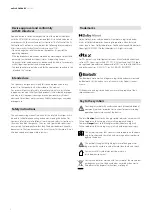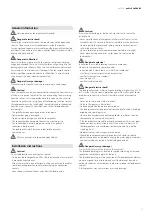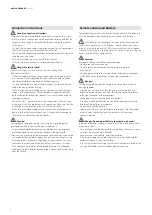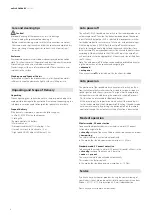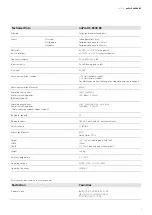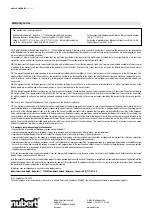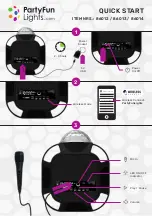
09/2022 ·
nuPro XS-8500 RC
5
reasonable distance from the respective end user.
• at the request of the end user, take back free of charge at the retail
outlet, or in the immediate vicinity thereof, waste equipment that does
not exceed 25 cm in any external dimension; take-back must not be
linked to the purchase of an electrical or electronic device and is limi-
ted to three old devices per type of device. In the case of distribution
using means of distance selling, the distributor must ensure appro-
priate return options at a reasonable distance from the respective end
user.
Batteries/Accumulator
Information according to the German battery
law (BatterieG)
Ingredients of batteries (e.g. chemicals) can damage the environment
and health if not stored and disposed of properly. In particular, lithium-
containing batteries must be handled with care due to the special risks,
e.g. fire hazard or risk of ingestion with button cells. At the same time,
recyclable raw materials may also be included. Batteries must therefore
not be disposed of with normal household waste. Separate collec-
tion can enable the recycling of raw materials; it also avoids negative
impacts on the environment and human health due to the release of
hazardous substances. As the end user, you are legally obligated to
return used batteries.
You can return batteries after use free of charge to a retail store or to
designated collection points (e.g. public collection points in your com-
munity or in stores). You can also return the batteries to the seller via
mail, observing the dangerous goods regulations if applicable.
The disposal in retail stores is limited to used batteries that the distribu-
tor carries or has carried in his product range in quantities customary for
disposal by end users.
The symbol with the crossed-out garbage can reminds you that you
must not dispose of batteries in municipal waste. Below this sign you
may find additional symbols with the following meaning regarding
content materials:
Pb = Battery contains more than 0.004 percent lead by mass,
Cd = Battery contains more than 0.002 percent cadmium by mass,
Hg = Battery contains more than 0.0005 percent mercury by mass.
To avoid littering and to reduce waste, it is recommended to use rechar-
geable batteries or batteries with a long service life. Long operational
time of electrical and electronic equipment is made possible using
replaceable accumulators. Littering of public spaces can be avoided
by disposing of batteries correctly. It may also be possible to reuse a
battery instead of disposing of it, for example by reconditioning or
refurbishing the battery. In addition, equipment and accumulators can
also be prepared for reuse, for example, by replacing or refurbishing the
accumulators.
Disposal of electrical and electronic devices
Information according to the German Act on Electrical
and Electronic Devices (ElektroG)
Owners of waste electrical and electronic devices must dispose of it
separately from unsorted municipal waste.
Meaning of the symbol „crossed-out trash can“
The crossed-out garbage can symbol regularly displayed
on electrical and electronic equipment and batteries
indicates that the respective device must be collected
separately from unsorted municipal waste.
Batteries, accumulators and lamps
Spent batteries and accumulators that are not enclosed by the waste
equipment, as well as lamps that can be non-destructively removed
from the waste equipment, have to be separated from the waste equip-
ment before handing it in at a collection point.
If the waste equipment is to be prepared for reuse with the participa-
tion of a public waste management authority, batteries and accumula-
tors as well as lamps do not have to be removed.
For the disposal of batteries and accumulators, please also observe the
following information on the battery law.
Deletion of data
Old devices may contain personal data. In your own interest, please
note that you, as the end user, are responsible for deleting the personal
data on the old devices to be disposed of before handing them in.
Options for the return of old devices
Owners of old devices from private households can hand them in free
of charge at the local collection points of the public waste disposal
authorities or at the collection points set up by manufacturers or dis-
tributors.
Distributors of electrical and electronic devices are obligated to take
back old devices free of charge in accordance with § 17 Sections 1 and
2 of the Electrical and Electronic Equipment Act (ElektroG). The take-
back process is as follows:
Distributors with a sales area of at least 400 m² for electrical and elect-
ronic equipment and distributors of groceries with a total sales area of
at least 800 m² who offer electrical and electronic equipment several
times per calendar year or on a permanent basis and make it available
on the market are subject to the obligation to take the devices back.
This applies in the case of distribution using means of distance selling
(e.g. online retailers), with the stipulation that the relevant floorspace
depends on the storage and shipping areas for electrical and electronic
equipment.
Distributors subject to the take-back obligation must,
• when supplying a new electric or electronic device to an end-user,
take back free of charge an end-user‘s old device of the same type that
fulfills essentially the same functions as the new device at the place of
supply or in the immediate vicinity thereof. If the device is delivered to
a private household, the consumer may demand the collection of the
old device at that location.
In the case of distribution using means of distance selling (e.g. online
store), free collection is limited to electrical and electronic equipment
in categories 1, 2 and 4, namely “heat exchanger”, “Screens, monitors
and devices containing screens with a surface area greater than 100
square centimeters” or “large equipment” (the latter with at least one
external dimension over 50 centimeters). For equipment in categories
3, 5 and 6, the distributor must ensure suitable return options within a


